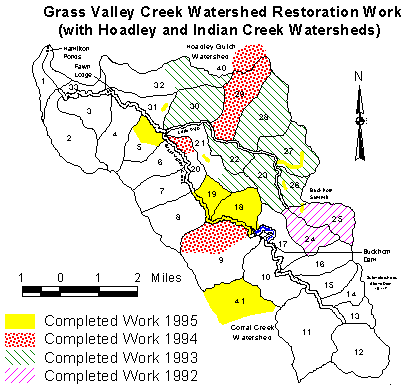Grass Valley Creek Watershed

Trinity County Resource Conservation District has contracted with the Trinity River Restoration Program through the Bureau of Reclamation to implement the rehabilitation of this watershed as part of the effort to restore the anadromous fishery in the Trinity River.
In 1992, the Natural Resource Conservation Service (formerly called the Soil Conservation Service) completed an Inventory of Sediment Sources in Grass Valley Creek. A total of 1,164 problem areas were identified as significant sediment producers which, if left untreated, would produce 377,000 cubic yards of sediment over the next 25 years.
GVC Watershed Restoration Accomplishments and Costs | |||||
|---|---|---|---|---|---|
| ACTIVITY | 1992 | 1993 | 1994 | 1995 | 1996 |
| Acres Treated | 1,170 | 4,418 | 2,250 | 2,250 | 1,000 |
| Number of Sites Treated | 50 | 346 | 196 | 103 | 75 |
| Road Reconstruction | 2.4 miles | 9 miles | 3 miles | 2.3 miles | 2.2 miles |
| Road Decommission | 1.5 miles | 22 miles | 20 miles | 1.4 miles | 0.5 miles |
| Revegetation - Trees, Shrubs & Grass Plugs | 80,000 | 150,000 | 135,000 | 126,000 | 70,700 |
| Total Expenditure | $380,000 | $1,255,000 | $1,784,000 | $1,040,000 | $456,000 |
Hoadley and Indian Creek Watersheds
Hoadley Gulch, which is immediately adjacent to the north of the GVC Watershed, consists of 3,500 acres underlain by decomposed granite parent materials. This watershed is also a significant contributor of sediment into the Trinity River. Historical logging practices and activities related to access and recreation have caused significant past and present disturbances in this watershed. The problems in this watershed include roads, crossings, landings in stream channels, poorly built and in-sloped roads and skids, as well as the removal of the forest canopy which provided suitable habitat for vegetation. In 1993, the Natural Resource Conservation Service (NRCS) completed a comprehensive inventory of sediment producing sites in the Hoadley Gulch watershed. In the 1,650 acres where access permission was granted, the inventory identified 52 individual problem sites for rehabilitation with an estimated 7,500 cubic yards of sediment production to be delivered over the next 25 years, if left untreated.
Indian Creek Watershed is located immediately adjacent to the southwest of the GVC Watershed and consists of 21,878 acres. Most of the problems identified in this watershed are due to road construction, timber harvest, past mining operations, and urban activities. Approximately 1,700 acres within the Indian Creek Watershed, primarily within the Corral Creek drainage area, were inventoried by the NRCS in 1993 and 189 problem sites were identified. These sediment sources, if left untreated would produce 75,311 cubic yards over the next 25 years.
The goal of the work in Grass Valley Creek, Hoadley Gulch, and Indian Creek Watersheds is to reduce the rate of sedimentation into the Trinity River in order to restore the fisheries.
RCD Restoration Efforts in the Grass Valley Creek & Indian Creek Watersheds
- GVC Restoration Manual ~ published March 1998 ~ (6.8Mb PDF)
- GVC Ten Year Planting Project Final Report (1.1 Mb PDF)
- GVC Ten Year Planting Project Final Report Appendix D (0.6 Mb PDF)
- GVC Ten Year Planting Project Final Report Appendix E-1 to E-11 (3.2 Mb PDF)
- GVC Ten Year Planting Project Final Report Appendix E-12 to E-22 (2.9 Mb PDF)
- GVC Reference Material
- Indian Creek Revegetation Plan (1997-1999) (2.4 Mb PDF)










